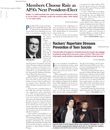APA has embarked on a sweeping effort to integrate all of the disparate information systems used by various areas of the Association into one core system.
That may sound like news in which only techno geeks would be interested, but the end result of the five-year, $3.5 million Project FUSION will be a more member-friendly APA.
“Project FUSION is not just an information technology project,” said William Bruce, director of information technology at APA. “It's about positive change for the entire Association. It will provide an improved membership experience and new tools and applications for district branches, and will simplify staff operations by integrating multiple functions into one core processing system.”
So, for instance, the database used by the Membership Department to manage member profiles and the database used by the Department of Association Governance to manage committee memberships will be integrated. These will then be linked to an APA Web site where members can access the information.
System to Save Time, Money
Bruce said one tangible member benefit envisioned by Project FUSION is that members will be able to go online and manage their information profiles; in time, they may be able to pay their member dues online and subscribe to APA publications.
Robert Hsiung, M.D., chair of APA's Ad Hoc Work Group on Information Systems, emphasized that Project FUSION will result in a better-functioning APA, inside and out. The work group provided overall guidance for the project.
“The main goal is to have APA be more coordinated,” Hsiung told Psychiatric News.
He likened the benefits of Project FUSION to those promised by the electronic medical record: coordination of services, improved efficiency, and lower cost. “Ultimately, it could help to make APA a more cost-efficient organization,” he said.
Currently many APA offices have data stored in systems that are not linked.
“For members, the first result of coordinating all this disparate data will be to make APA less confusing. If a member moves, for instance, he or she should have to change his or her address only once, and the whole system should know the new address,” he said.
Likewise, from the Association's perspective, the integration will improve efficiency: when a member moves to a new district branch, that member's information will be readily accessible to the new DB through a specially designed Web interface.
Disparate Systems, Disparate Functions
Bruce explained that APA's current information systems evolved“ helter skelter,” beginning in about 1990, when many of the Association's functions were still carried out manually. One by one, departments developed separate systems for specific functions. There was no long-term vision for making the systems work together and serve the Association's broader member needs.
The result, he said, has been a hydra-head of 43 systems: 10 specialized applications used by management, three by Association Governance, six by American Psychiatric Publishing Inc. (APPI), seven by the Annual Meetings Office, five by the Division of Education and Career Development, and seven by other areas. The APA Web site adds five separate applications.
“Technology is everywhere but is poorly organized, and the systems were implemented to mimic earlier manual processes,” Bruce said.
Seeking from the initial planning stages to find a product that would be“ ready made” and require little customization, APA turned to the TIMSS Association Management System, marketed by TMA Resources of Vienna, Va.
According to the TMA Resources Web site, TIMSS is a multitiered, component-based system designed to anticipate member-specific needs. Built-in flexibility allows customers to modify the system without the cost of custom scripting or programming.
The TIMSS product has been used by professional societies such as the American Institute of Architects, American Urological Association, American Symphony Orchestra League, and North American Radiological Society.
Bruce told Psychiatric News that the membership and governance systems will be the first to be integrated, with integration completed by the end of this summer. The second phase of integration, tentatively slated to be completed by the end of 2006, will involve systems used by the Division of Education and Career Development, Division of Advocacy, and the Office of HIV/AIDS Psychiatry. The final phase of integration will involve the systems used by APPI, American Psychiatric Foundation, and Annual Meetings Office.
The new system is expected to be implemented and fully accessible by mid-2007.
APA members can follow the progress of the project in the quarterlyFusion Focusnewsletter. The December issue, posted at<http://psych.org/members/newsletters/fusion/FUSIONFocus1—3.pdf>, is the most recent. More information is also available from William Bruce at (703) 907-7828. Information about TMA Resources and the TIMSS product is posted online at<www.tmaresources.com>.▪
